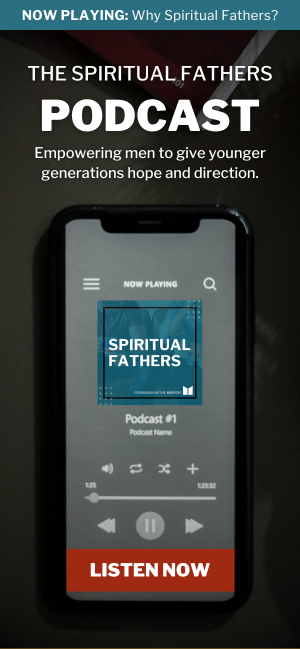An Uncharted Heart Journey for Men
Males face a sea change of cultural cross currents. Amid confusing, contradictory messages about masculinity, to ask the question, “What does it mean to be a godly man?” within our cultural context has to mean more than a tacit return to a nostalgic past.

By Guest Writer John Seel
Writer, Consultant, and Cultural Analyst
Lafayette Hill, PA
This is the third article in our current series on reaching younger men.
Being male is not woke.
In today’s world, there is a stigma around being male. If we are going to walk with younger men effectively, we must recognize and acknowledge the shifting social and cultural ground they stand on—and frankly that all of us stand on.
Words like patriarchy and misogyny dominate the cultural dialogue. Certainly, some of this stigma around being male has been deserved, as the recent #metoo movement has highlighted.
Adding to this is further stigma attached to a man’s race. For example, the assumption is that white males are privileged and complicit. And this does not even touch on the complexity of being a black or brown male in America, both of whom are often indiscriminately targeted.
Being male is seen as a problem and we can no longer ignore it.
Being male is not woke.Click To TweetThe Perceived Problem of Masculinity
If being masculine is perceived as a problem that can’t be ignored, the reaction to that perception also can’t be ignored. For example, an extreme community of men have gathered on the Internet to air their grievances and confusion. The Incel movement (“involuntarily celibates”) has highlighted a deep sense of victimhood and nostalgia. At the same time, it has aggravated and celebrated the two fatal flaws in traditional ersatz masculinity: violence and lust.
While the majority of men aren’t reacting in these extremes, they are still being impacted. Under the best of circumstances, men are not adept in talking, being vulnerable, or being honestly self-conscious of their inner lives. Now, this widespread cultural stigma has only encouraged silence and isolation.
The result is there are very few places where men can safely and productively discuss confusion about what it means to be male.
In this context, the church has remained complicity silent. It tends to offer spiritual platitudes and religious clichés to what is nothing less than an existential crisis in masculine identity. Rather than calling men to really examine their hearts, the church tends to call them to more activism and intellectualism, further cutting them off from self-reflection.
Young men will continue to leave the church in droves if it ignores, or appears irrelevant to, this deeply felt confusion—or worse, if their confusion is papered over with moralistic judgment. The reality is that many of our churches are not safe places for them to talk about spiritual doubt, much less the hook-up culture, pornography, or rage. It’s far more common to grab our dusty Bibles, put on an artificial smile, and pretend that all is well—when in our heart of hearts we know this is not the case. Deep fissures are emerging in the facade of this spiritual artificiality.
How We Got Here
What has contributed to the lack of stability and understanding of what it means to be male?
Some point to the domestication of masculinity brought about by the conveniences of modern life. Their solution is calling men to restore their sense of adventure and wildness. (Contact sports and violent video games are seen as some domesticated symptoms of this unmet longing, while spousal abuse and sexual assault are some of its less domesticated consequences.)
Others point to the fact that many men have no positive male role models. There are entire segments of the population where boys have no experience of or even knowledge of an intact family. Fathers are absent by choice or imprisonment. If it is true that only men can call boys to be men, then we have a chronic structural problem in the maturation of men. Gangs and other surrogate families are replacing the role of the traditional father.
But this assumes that if fathers were present, they would be equipped to model mature manhood. This is hardly assured. Some components of feminism have resulted in old role assumptions unraveling and old patterns of abuse being revealed. And while there is much that is healthy and welcomed in this, it has left men fundamentally disoriented. In extreme forms, it has contributed to males being culturally despised.
On top of all these factors, the work world, where men felt like they had a secure standing, is also being eroded. There is no security in work, especially for younger men new to the workforce. Entry-level positions with opportunity to advance, earn a living to support one’s family, and retire at 65 with a pension are extinct. In addition, the recent economic insecurity caused by the COVID-19 shutdown will be soon followed by the obsolescence of many jobs due to the onset of the Fourth Industrial Revolution. According to the Future of Employment report, around 47 percent of total US employment is at risk of disappearing in the future.
Added to this is the widespread concept of gender fluidity. The very notion of masculinity is being erased, qualified, or blurred. Being male is not only not “woke,” it may not even be a thing.
Males face a sea change of cultural cross currents. Having dominated society in the past, this is now changing (rightfully so), and what it means in the future for men is still unclear. In the face of these currents, uncertainty and insecurity are common and justified.
How the Church Responds
For the church, simply relying on atavistic solutions for the issues surrounding masculinity is not going to be enough. Abandoned, despised, confused, and disposed of, young men especially are trying to navigate a course in a storm when all the tools of navigation are no longer operational.
To ask the question, “What does it mean to be a godly man?” within our cultural context has to mean more than a tacit return to a nostalgic past.
To ask the question, “What does it mean to be a godly man?” within our cultural context has to mean more than a tacit return to a nostalgic past.Click To TweetDepictions of “godly men” based on a past time in American life turn out to be far more culturally defined than what one finds in the life and person of Jesus. For just as Sunday school illustrations of Jesus tell us as much about the artist and his or her cultural context as they do about Jesus, so too do our descriptions of “godly men” when they are limited to some archetype from our past.
The actual life and person of Jesus (not merely a white, suburban, misty-eyed Jesus) is perhaps where the conversation needs to begin and it is one we must have, because collectively these issues facing men today present complex psychological and sociological challenges.
The past is not going to be much help and the status quo is clearly inadequate. This is true for white and black men, churched and unchurched men, young and old men alike.
When we’ve been conditioned to view vulnerability as weakness, it makes it hard to open up to each other. And so all of these cultural factors and the feelings they create can become repressed—bottled up in a slow simmering cauldron of resentment, confusion, and paralysis. Where does it end?
There is a scary heart journey ahead that we must take as we explore these challenges together as a band of brothers. As Christian leaders, the responsibility is ours to create the safe places for these unsafe conversations.
As Christian leaders, the responsibility is ours to create safe places for unsafe conversations.Click To TweetFor you to consider and discuss:
- With whom can I talk about these matters?
- What does it mean today to be a godly man?
- How much of my views on godly manhood have been shaped by my culture?
- Am I personally willing to regularly think about my own inner life?
- Can I encourage my church to partner with me on this pilgrimage?
THE BIG IDEA: As Christian leaders, the responsibility is ours to create the safe places for these unsafe conversations.
♦♦♦







